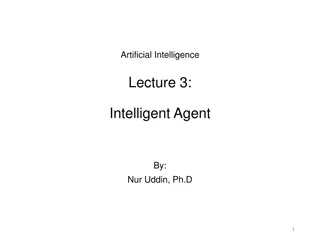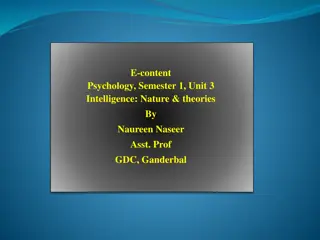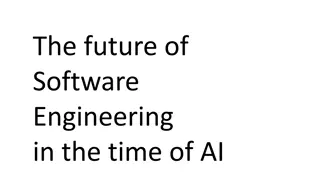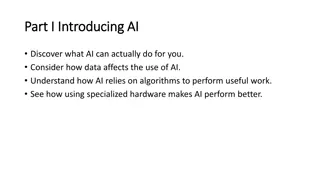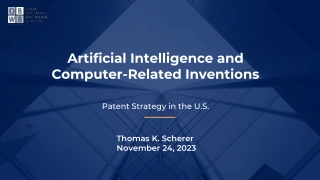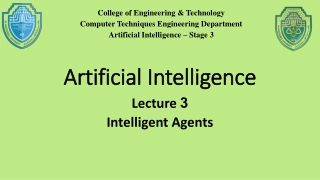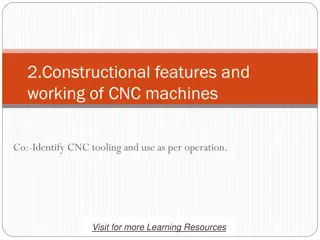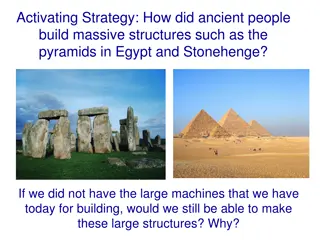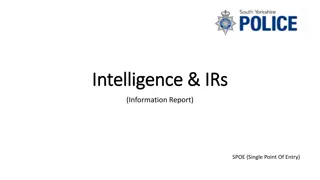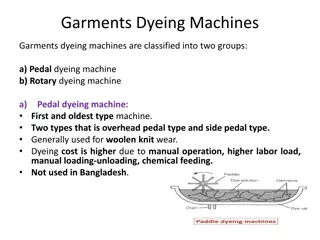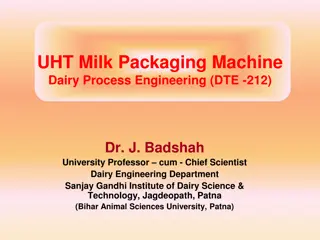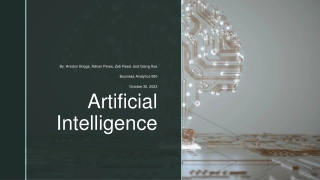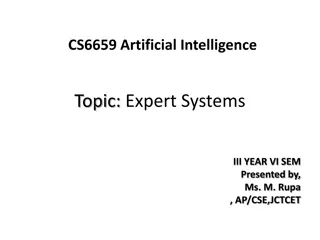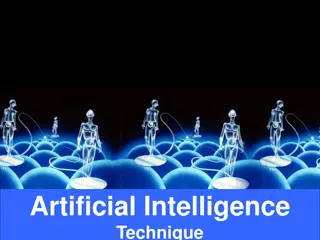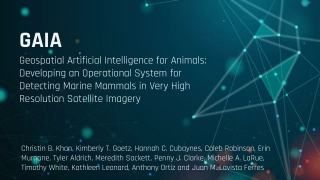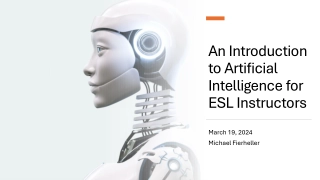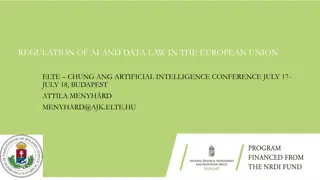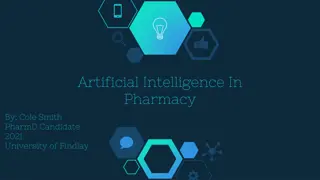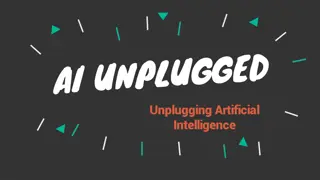Understanding Artificial Intelligence: Building Intelligent Machines
Artificial Intelligence (AI) is the science and engineering behind creating intelligent machines that can think, perceive, and act like humans. It involves machine learning technologies, algorithms, and models that enable computers to perform tasks requiring human intelligence. AI encompasses a multidisciplinary approach and utilizes technologies such as machine learning, robotics, cloud computing, and more. The components of AI systems include applications like recognition and chatbots, various types of models like deep learning and neural networks, and the use of software/hardware for training and running models. Historical aspects of AI date back to its formal initiation in 1956, where general-purpose computers facilitated the creation of artificially intelligent entities.
Download Presentation

Please find below an Image/Link to download the presentation.
The content on the website is provided AS IS for your information and personal use only. It may not be sold, licensed, or shared on other websites without obtaining consent from the author. Download presentation by click this link. If you encounter any issues during the download, it is possible that the publisher has removed the file from their server.
E N D
Presentation Transcript
What is Artificial Intelligence? is it possible to build a machine that has intelligence, specifically a human level of intelligence? Artificial Intelligence is The science and engineering of making intelligent machines, especially intelligentcomputerprograms. About algorithms enabled representations that support models targeted at thinking, perception and action. The theory and development of computer systems able to perform tasks normally requiring human intelligence, such as visual perception, speech recognition, decision-making, and translation between languages. by constraints exposed by 1
Contd AI is the creation of a computer program that can learn to think and function on its own, kind of like robots that don t need to be told what to do all the time. Most advanced AI systems use machine learning technology to analyze current conditions and learn from experience. 2
Contd Examples of technologies that uses AI Machine Learning Robotics Machine Automation Virtual Reality Cloud Computing Augmented Reality Neural Networks Big Data Internet of Things Computer Vision 3
Components of AI system Applications: recognition, Chatbots, Natural language generation, and Sentiment analysis. 2. Types of Models: Deep learning, Machine learning, and Neural Networks. 3. Software/Hardware for training and running models: Graphic Processing Units (GPUs), Parallel processing tools (like Spark), Cloud data storage and computer platforms. 4. Programming languages for building models: Python, TensorFlow, Java, and C/C++, etc. Image recognition, Speech 1. 5
Artificial Intelligence (AI), Machine Learning (ML) and Deep Learning (DL) 6
History of Artificial Intelligence (AI) Formally initiated in 1956 and the name AI was coined by John McCarthy. The advent of general purpose computers provided a vehicle for creating artificially intelligent entities. Used for solving general-purpose problems Which one is preferred? General purpose problem solving systems Domain specific systems 7
Contd Year Description 1956 The term artificialintelligence is coined by John McCharty at a Dartmouth conference and AI is founded as an academic discipline 1956 1974 The golden years of AI enjoy government funding in promising, logic-based problem-solving approaches. 1974 1980 Overly high expectations coupled with the limited capacities of AI programs leads to the first AIwinter , with reduced funding and interest in AI research. 1980 1987 The rise of knowledge-based expert systems brings new successes and a change in the focus of research and funding toward this form of AI. 1987 1993 The second AIwinter starts with the sudden collapse of the specialized hardware industry in 1987. The AI hype brings with it negative perceptions by governments and investors, as expert systems show their limitations and prove expensive to update and maintain. 9
Contd 1993 2011 Optimism about AI returns and increases. New successes are marked with the help of increased computational power and AI becomes data-driven. In 1997, IBM s DeepBlue beats world champion Gary Kasparov at chess. In 2002, Amazon uses automated systems to provide recommendations. In 2011, Apple releases Siri and IBM Watson beats two human champions at the TV quiz Jeopardy. 2012 today Increased computational power allow for breakthroughs in machine learning, mainly in neural networks and deep learning, heralding a new era of increased funding and optimism about the AI potential. availability of data, connectedness and In 2012, Google driverless cars navigate autonomously and in 2016 Google AlphaGo beats a world champion in the complicated board game Go. 10
Types of Artificial Intelligence(AI) Based on the level of intelligence embedded into a machine AI is divided into three. Artificial Narrow Intelligence (Weak AI or Narrow AI 2. Artificial General Intelligence (General AI or Strong AI) 3. Artificial Super Intelligence (Super AI) 1. 12
Contd 1. Artificial Narrow Intelligence (Weak AI or Narrow AI) A type of AI which is able to perform a dedicated task with intelligence. The most common and currently available. It is only trained for one specific task, cannot perform beyond its field or limitations Example of narrow AI Playing chess, Purchasing suggestions on e-commerce site, Self-driving cars, Speech recognition, and Image recognition. 14
Contd 2. Artificial General Intelligence (General AI or Strong AI) a type of intelligence which could perform any intellectual task with efficiency like a human. The idea is to make a system which could be smarter and think like a human by its own. General AI systems are still under research. 15
Contd 3. Artificial Super Intelligence (Super AI) a level of Intelligence of Systems at which machines could surpass human intelligence, and can perform any task better than human with cognitive properties. an outcome of general AI. Characteristics of strong AI include the ability to think, to reason, solve the puzzle, make judgments, plan, learn, and communicate by its own. Development of such systems in real is still world changing task. 16
Contd Based on capabilities Reactive Machines: Purely reactive machines are the most basic types of Artificial Intelligence. Such AI systems do not store memories or past experiences for future actions. These machines only focus on current scenarios and react on it as per possible best action. 1. IBM's Deep Blue system and Google s AlphaGo is an example of reactive machines. Google Alpha Go IBM Deep Blue Super Computer 17
Contd 2. Limited Memory: Limited memory machines can store past experiences or some data for a short period of time. These machines can use stored data for a limited time period only. Self-driving cars are one of the best examples of Limited Memory systems. These cars can store recent speed of nearby cars, the distance of other cars, speed limit, and other information to navigate the road. 18
Contd 3. Theory of Mind: Theory of Mind AI should understand the human emotions, people, beliefs, and be able to interact socially like humans. This type of AI machines are still not developed, but researchers are making lots of efforts and improvement for developing such AI machines. Sophia the humanoid robot is one example of such effort where a number of young Ethiopians have contributed on the development.[ 19
Contd 4. Self Awareness: Self-awareness AI is the future of Artificial Intelligence. These machines will be super intelligent, and will have their own consciousness, sentiments, and self-awareness. These machines will be smarter than human mind. Self-Awareness AI does not exist in reality still and it is a hypothetical concept. 20
Applicationsof AI Currently, AI is being applied across several industries. But we cannot say that AI is replacing humans but it is certainly making the work of human beings more efficient. Agriculture AI technologies are being used to yield healthier crops, control pests, monitor soil and growing conditions, organize data for farmers, help with workload, and improve a wide range of agriculture-related tasks in the entire food supply chain. 1. 21
Contd Agricultural Robots Companies autonomous robots to handle essential agricultural tasks such as harvesting crops at a higher volume and faster pace than human laborers. Examples of AI applications in the agriculture sector. are developing and programming See & Spray Robot Harvest CROO Robotics Crop and Soil Monitoring 22
Contd 2. Health AI applications are revolutionizing how the health sector works to reduce spending and improve patient outcomes. Companies are applying machine learning to make better and faster diagnoses than humans. One of the best known healthcare technologies is IBM Watson. Other AI applications include chatbots. 23
Contd Personal Health Virtual Assistant Examples of AI applications in the health sector. Dip.io Apple Watch Medical Imaging Analysis IBM Watson analysis IDx software Precision Medicine Healthcare Bots Operational applications of AI 24
Contd 3. Business (Emerging market) Artificial Intelligence has enormous potential to augment human intelligence and to radically alter how we access products and services, gather information, make products, and interact. In emerging markets, AI offers an opportunity to lower costs and barriers to entry for businesses and deliver innovative business models that can leapfrog traditional solutions and reach the underserved. 25
Contd Examples of AI applications in the Business sector. Improve Customer Services Automate Workloads Optimize Logistics Increase Manufacturing Output and Efficiency Prevent Outages Predict Performance Predict Behavior Manage and Analyze Data Improve Marketing and Advertising 26
Contd 4. Education The increasing adoption of the AI technology for various applications in the education sector. AI can automate grading, giving educators more time, and can also assess students and adapt to their needs, helping them work at their own pace. AI tutors can provide additional support to students, ensuring they stay on track. 27
Contd Examples of AI applications in the Education sector. Administrative Tasks Automation Smart Content Smart Tutors and Personalization Virtual Lectures and Learning Environment Teachers Support Students Communication 28




